The article “Navigating Fashion Trends: What to Keep and What to Skip” explores the significance of fashion trends, their influence on personal style, and the cultural and social factors that shape them. It categorizes trends into seasonal, timeless, fast fashion, and micro-trends, highlighting the importance of understanding their longevity and relevance. The article provides practical strategies for incorporating trends into wardrobes sustainably, emphasizing the need to prioritize quality over quantity and to recognize fleeting trends that may not align with personal style. Additionally, it discusses the role of sustainability in modern fashion and offers tips for building a versatile capsule wardrobe.
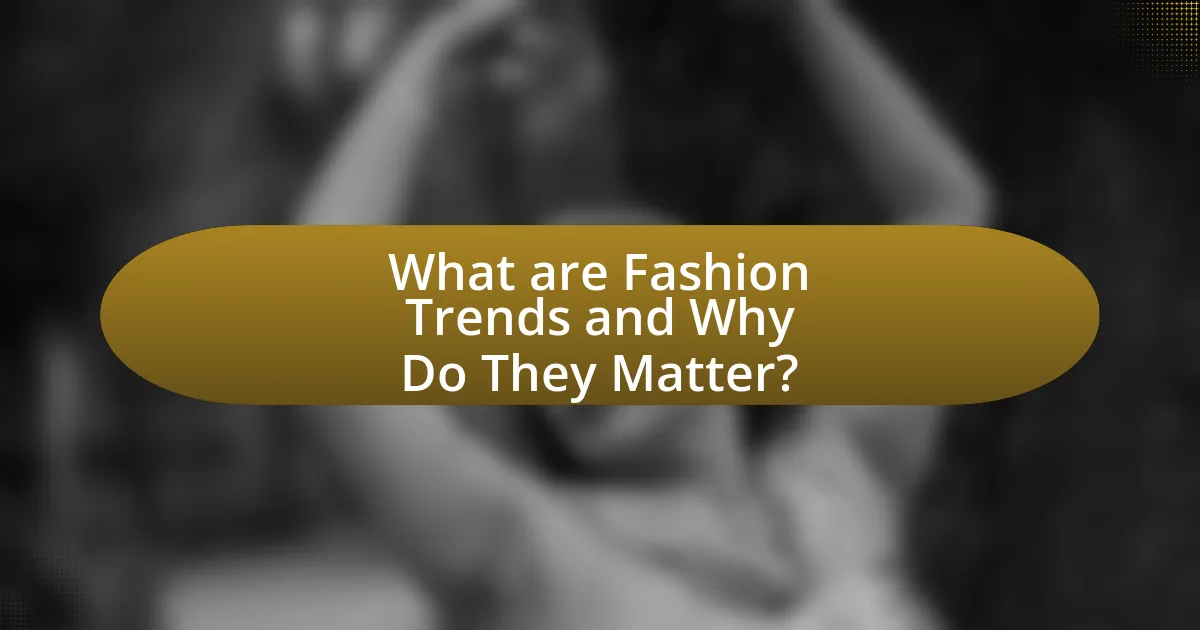
What are Fashion Trends and Why Do They Matter?
Fashion trends are the popular styles and designs that emerge within the fashion industry, influencing what consumers wear at any given time. They matter because they reflect cultural shifts, consumer preferences, and societal values, often driving economic activity within the fashion sector. For instance, the rise of sustainable fashion trends in recent years highlights a growing consumer demand for environmentally friendly practices, which has led to significant changes in production methods and marketing strategies among major brands.
How do fashion trends influence personal style?
Fashion trends significantly influence personal style by providing a framework of popular aesthetics and choices that individuals can adopt or adapt. These trends often emerge from cultural shifts, celebrity endorsements, and social media, shaping what is considered fashionable at any given time. For instance, the rise of athleisure in the 2010s, driven by influencers and lifestyle changes, led many to incorporate sporty elements into their everyday wardrobes, blending comfort with style. This demonstrates how trends can redefine personal style by introducing new silhouettes, colors, and materials that individuals may choose to integrate into their unique expressions of fashion.
What role do cultural and social factors play in shaping trends?
Cultural and social factors significantly influence the development and evolution of trends. These factors shape consumer preferences, behaviors, and values, which in turn dictate what becomes popular in fashion. For instance, the rise of sustainability in fashion is largely driven by social movements advocating for environmental responsibility, reflecting a collective shift in societal values towards eco-consciousness. Additionally, cultural phenomena, such as music, art, and film, often inspire fashion trends, as seen with the influence of hip-hop culture on streetwear styles. This interplay between culture and social dynamics creates a feedback loop where trends emerge, evolve, and sometimes fade based on the prevailing cultural narratives and social contexts.
How can understanding trends enhance wardrobe choices?
Understanding trends enhances wardrobe choices by enabling individuals to make informed decisions that align with current styles and personal preferences. By staying updated on fashion trends, individuals can select pieces that not only reflect their identity but also ensure they remain relevant in social and professional settings. For instance, a study by the Fashion Institute of Technology found that consumers who follow trends are more likely to feel satisfied with their clothing choices, as they feel connected to contemporary culture. This connection can lead to increased confidence and self-expression through fashion.
What are the different types of fashion trends?
Fashion trends can be categorized into several types, including seasonal trends, timeless trends, fast fashion trends, and micro-trends. Seasonal trends are influenced by the fashion calendar and typically change with each season, reflecting current styles and colors. Timeless trends, also known as classic styles, remain popular over time, such as the little black dress or denim jeans. Fast fashion trends emerge quickly, often driven by social media and celebrity influence, leading to rapid production and consumption. Micro-trends are short-lived, often lasting only a few months, and can be sparked by viral moments or niche communities. Each type of trend plays a distinct role in shaping consumer behavior and the fashion industry.
What distinguishes seasonal trends from timeless styles?
Seasonal trends are characterized by their temporary nature, often influenced by current events, cultural shifts, or fashion cycles, while timeless styles remain consistent and relevant across different eras. Seasonal trends typically emerge from fashion weeks and are designed to cater to the immediate preferences of consumers, often changing with each season, as evidenced by the rapid turnover of collections in retail. In contrast, timeless styles, such as the little black dress or classic denim jeans, have proven their longevity and adaptability, remaining fashionable regardless of changing trends, as supported by their continued presence in wardrobes over decades.
How do micro-trends differ from macro-trends?
Micro-trends are short-lived, niche trends that emerge quickly and often cater to specific subcultures or demographics, while macro-trends are broader, long-lasting shifts that influence entire industries or societies over extended periods. For example, a micro-trend might involve a specific style of footwear gaining popularity among a small group, whereas a macro-trend could be the overall shift towards sustainable fashion that affects multiple brands and consumer behaviors globally. This distinction is crucial for understanding how trends evolve and impact the fashion landscape, with micro-trends often serving as precursors or indicators of potential macro-trends.
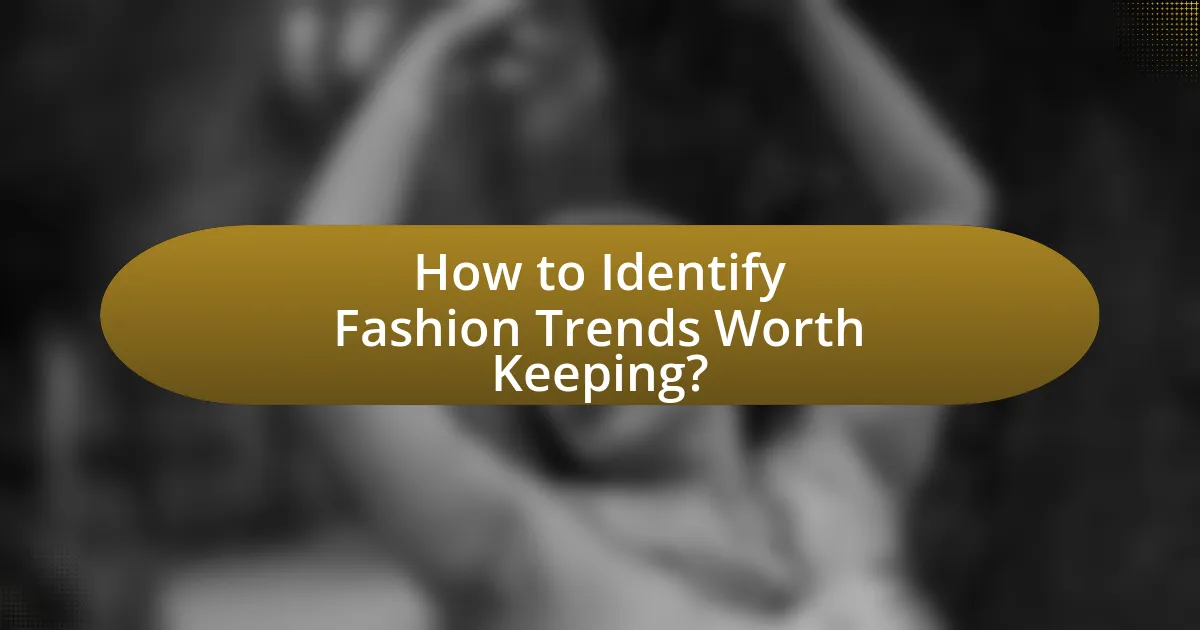
How to Identify Fashion Trends Worth Keeping?
To identify fashion trends worth keeping, analyze their longevity, versatility, and cultural relevance. Trends that have shown staying power over multiple seasons, such as high-waisted jeans or oversized blazers, indicate a solid foundation for longevity. Versatility is crucial; trends that can be styled in various ways or adapted to different occasions, like the little black dress, are more likely to remain relevant. Cultural relevance also plays a significant role; trends that resonate with current societal movements or values, such as sustainable fashion, tend to gain traction and acceptance. Historical data shows that trends aligning with these criteria often lead to increased consumer interest and sales, reinforcing their worth in the fashion landscape.
What criteria should you use to evaluate a trend?
To evaluate a trend, consider criteria such as relevance, longevity, and market demand. Relevance assesses how well the trend aligns with current consumer interests and cultural movements, ensuring it resonates with the target audience. Longevity examines whether the trend has the potential to endure over time or if it is merely a fleeting fad, which can be determined by historical patterns in fashion cycles. Market demand analyzes sales data and consumer behavior to gauge the trend’s acceptance and profitability, providing concrete evidence of its viability. These criteria collectively help in making informed decisions about which trends to adopt or discard in the fashion industry.
How does personal style impact the decision to keep a trend?
Personal style significantly influences the decision to adopt or retain a trend, as individuals often align trends with their unique aesthetic preferences and self-expression. When a trend resonates with a person’s established style, it is more likely to be embraced and integrated into their wardrobe, reinforcing their identity. For instance, a study published in the Journal of Fashion Marketing and Management found that consumers are more inclined to adopt trends that reflect their personal values and lifestyle, indicating that personal style serves as a filter for trend acceptance. This alignment not only enhances the individual’s confidence but also contributes to the longevity of the trend within their personal fashion choices.
What are the signs of a trend having lasting power?
A trend demonstrates lasting power when it consistently influences consumer behavior over an extended period. Key signs include widespread adoption across various demographics, sustained media coverage, and integration into core product lines by major brands. For instance, the athleisure trend has maintained its popularity since the early 2010s, evidenced by a 2020 report from Grand View Research indicating a market size of $155 billion, projected to grow significantly. Additionally, trends that evolve and adapt, such as sustainable fashion, show resilience as they align with changing consumer values and environmental awareness, further solidifying their lasting impact.
How can you incorporate trends into your wardrobe effectively?
To incorporate trends into your wardrobe effectively, focus on selecting a few key pieces that resonate with your personal style and can be easily integrated with your existing clothing. This approach allows you to stay current without overhauling your entire wardrobe. For instance, if oversized blazers are trending, choose one that complements your body shape and can be paired with various outfits, such as jeans or dresses. Research indicates that incorporating just 20% of trendy items can refresh your wardrobe while maintaining a cohesive look, as suggested by fashion experts.
What are the best practices for mixing trends with classic pieces?
The best practices for mixing trends with classic pieces include selecting one or two trendy items to pair with timeless staples, ensuring balance in proportions, and maintaining a cohesive color palette. By incorporating a trendy accessory, such as a statement bag or shoes, alongside classic clothing like a tailored blazer or little black dress, individuals can achieve a modern look without overwhelming their style. Additionally, balancing proportions—such as pairing a fitted top with wide-leg trousers—creates visual interest while keeping the outfit grounded in classic elements. A cohesive color palette further enhances the overall aesthetic, allowing for seamless integration of trendy and classic pieces.
How can you adapt trends to suit your body type and lifestyle?
To adapt trends to suit your body type and lifestyle, first identify your unique body shape and proportions, as this knowledge allows for selecting styles that enhance your best features. For instance, individuals with an hourglass figure may choose fitted clothing to accentuate their waist, while those with a rectangular shape might opt for layered outfits to create the illusion of curves.
Additionally, consider your lifestyle when incorporating trends; for example, if you lead an active lifestyle, prioritize comfortable, functional fabrics that allow for movement while still reflecting current styles. Research shows that understanding body types can lead to improved self-esteem and satisfaction with personal style choices, as noted in a study published in the Journal of Fashion Marketing and Management. This approach ensures that the trends you adopt not only align with fashion but also complement your individual needs and preferences.
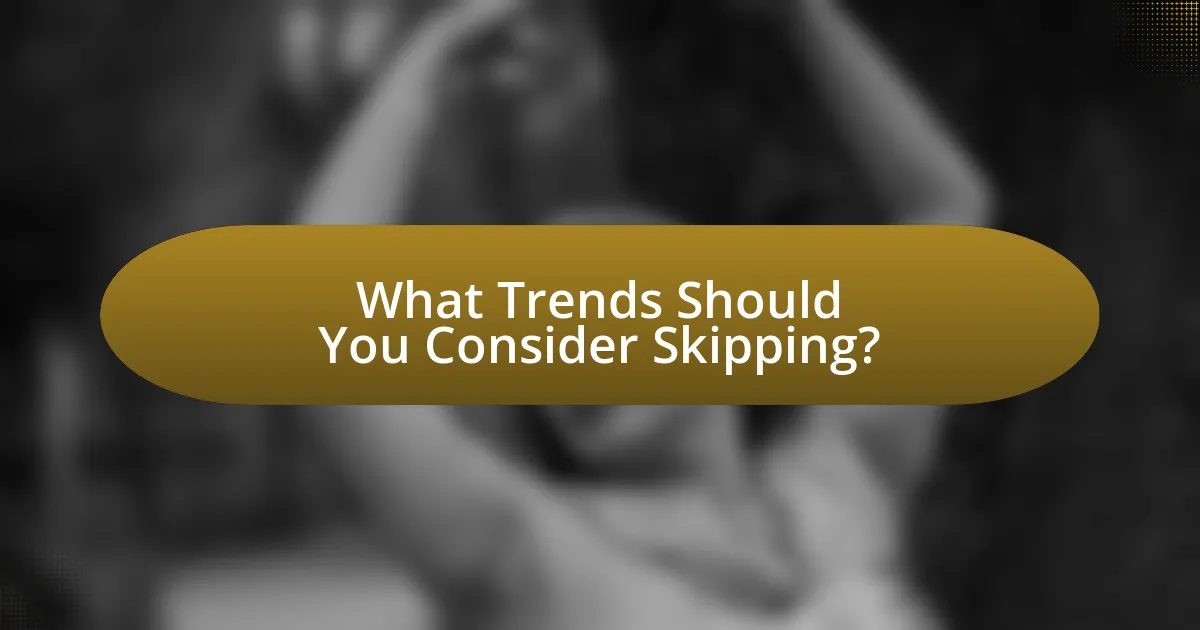
What Trends Should You Consider Skipping?
Consider skipping trends that prioritize fast fashion, such as overly extravagant designs or unsustainable materials. Fast fashion contributes significantly to environmental degradation, with the industry responsible for 10% of global carbon emissions and a substantial amount of waste. Additionally, trends that lack versatility, like overly specific styles that cannot be integrated into a broader wardrobe, should also be avoided, as they lead to unnecessary purchases and clutter. By focusing on timeless pieces and sustainable practices, consumers can make more responsible fashion choices.
How can you identify fleeting trends that may not be worth the investment?
To identify fleeting trends that may not be worth the investment, analyze the trend’s longevity and market demand. Trends that gain rapid popularity but lack historical precedent or consumer loyalty often fade quickly. For instance, the rise and fall of “fidget spinners” in 2017 illustrates how a product can spike in interest but lose traction within months, resulting in significant financial losses for investors. Additionally, monitoring social media engagement and sales data can provide insights; trends with high initial buzz but low sustained engagement typically indicate a lack of lasting value.
What are the risks of following every trend blindly?
Following every trend blindly can lead to financial waste, identity dilution, and social pressure. Financially, individuals may spend excessively on fleeting trends that quickly become obsolete, resulting in a cluttered wardrobe and wasted resources. Identity dilution occurs when people lose their personal style, conforming to trends rather than expressing individuality, which can lead to dissatisfaction and a lack of authenticity. Socially, the pressure to keep up with trends can create stress and anxiety, as individuals may feel compelled to constantly update their appearance to fit in, potentially harming mental well-being. These risks highlight the importance of critical evaluation and personal alignment when engaging with fashion trends.
How can you recognize when a trend is becoming over-saturated?
A trend is becoming over-saturated when there is a noticeable decline in consumer interest and engagement, often indicated by a significant increase in the number of similar products or styles flooding the market. This can be evidenced by metrics such as reduced sales figures, a rise in discounting practices, and a lack of media coverage or social media buzz surrounding the trend. For instance, when a specific fashion item, like a type of sneaker, sees a rapid increase in availability across multiple brands and retailers, it often leads to consumer fatigue, signaling that the trend may be losing its appeal.
What are the common pitfalls of trend-following?
Common pitfalls of trend-following include overreacting to short-term market movements, leading to impulsive decisions that can result in losses. Traders often enter positions based on hype rather than solid analysis, which can lead to buying high and selling low. Additionally, trend-followers may neglect risk management, exposing themselves to significant drawdowns during trend reversals. Historical data shows that many trend-following strategies underperform during sideways markets, as they rely on clear directional movements to generate profits.
How can impulse buying lead to wardrobe regret?
Impulse buying can lead to wardrobe regret by resulting in the acquisition of items that do not align with an individual’s personal style or needs. When consumers make spontaneous purchases, they often overlook factors such as fit, versatility, and overall compatibility with existing wardrobe pieces. Research indicates that approximately 70% of impulse purchases are later regretted, as these items frequently remain unworn or are discarded, contributing to a cluttered closet and financial waste. This disconnect between impulse purchases and actual wardrobe utility highlights the importance of mindful shopping to avoid future dissatisfaction.
What are the signs that a trend does not align with your personal style?
Signs that a trend does not align with your personal style include discomfort when wearing the trend, a lack of enthusiasm for the items, and feeling out of place in social settings. Discomfort can manifest as physical unease or emotional disconnection, indicating that the trend does not resonate with your identity. A lack of enthusiasm suggests that the trend does not excite or inspire you, which is essential for personal expression. Additionally, feeling out of place can signal that the trend clashes with your established aesthetic, reinforcing the idea that it does not fit your personal style.
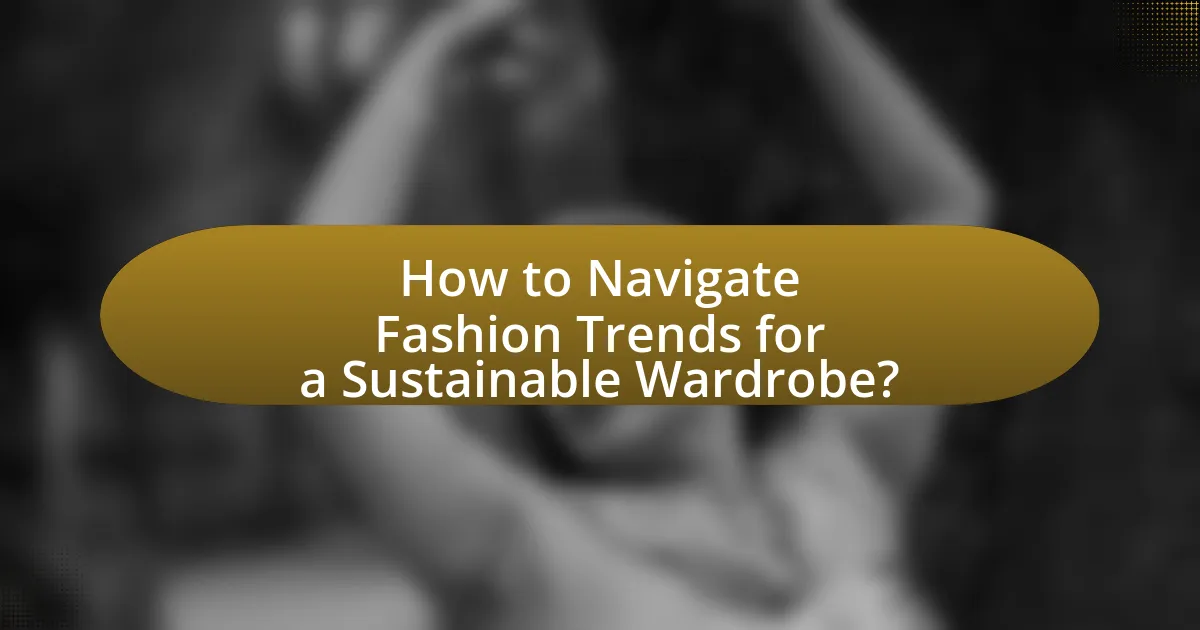
How to Navigate Fashion Trends for a Sustainable Wardrobe?
To navigate fashion trends for a sustainable wardrobe, prioritize timeless pieces over fleeting trends. Timeless clothing, such as classic cuts and neutral colors, reduces the need for frequent purchases, thereby minimizing waste. According to a 2021 report by the Ellen MacArthur Foundation, the fashion industry is responsible for 10% of global carbon emissions, highlighting the importance of sustainable choices. By investing in high-quality, versatile items that can be styled in various ways, consumers can create a sustainable wardrobe that aligns with current trends while reducing environmental impact.
What strategies can help you build a timeless wardrobe?
To build a timeless wardrobe, focus on selecting classic pieces that never go out of style, such as a well-fitted blazer, a little black dress, and quality denim. These items are versatile and can be styled for various occasions, ensuring longevity in your wardrobe. Research indicates that investing in high-quality materials and craftsmanship leads to durability, which is essential for a timeless wardrobe. For example, a study by the Fashion Institute of Technology highlights that garments made from natural fibers like wool and cotton tend to last longer and maintain their appearance better than synthetic alternatives. Therefore, prioritizing classic styles and quality materials will help create a wardrobe that remains relevant over time.
How can you prioritize quality over quantity in your fashion choices?
To prioritize quality over quantity in fashion choices, focus on selecting fewer, high-quality pieces that offer durability and timeless style. Investing in well-made garments from reputable brands ensures longevity and reduces the need for frequent replacements, ultimately saving money in the long run. Research indicates that consumers who prioritize quality often experience greater satisfaction and wearability from their clothing, as high-quality fabrics and craftsmanship contribute to a better fit and aesthetic appeal.
What role does sustainability play in modern fashion trends?
Sustainability plays a crucial role in modern fashion trends by driving consumer demand for eco-friendly practices and materials. As awareness of environmental issues grows, brands are increasingly adopting sustainable practices, such as using organic materials, reducing waste, and implementing ethical labor standards. For instance, a 2021 McKinsey report highlighted that 67% of consumers consider sustainability when making a purchase, indicating a significant shift in consumer behavior. This trend has led to the rise of sustainable fashion brands and the incorporation of circular economy principles, where products are designed for longevity and recyclability.
What practical tips can you apply when navigating fashion trends?
To effectively navigate fashion trends, prioritize understanding your personal style and body type. This foundational knowledge allows you to select trends that enhance your appearance rather than conforming to every fleeting fashion. Additionally, invest in versatile pieces that can be styled in multiple ways, ensuring longevity in your wardrobe. Research shows that consumers who focus on timeless styles rather than fast fashion reduce waste and save money over time. Lastly, follow fashion influencers or platforms that align with your aesthetic to stay informed about trends that resonate with you, enabling informed choices that reflect your individuality.
How can you create a versatile capsule wardrobe that incorporates trends?
To create a versatile capsule wardrobe that incorporates trends, select a foundational set of timeless pieces and strategically add a few trendy items each season. Timeless pieces include classic items like a tailored blazer, well-fitting jeans, and neutral tops, which provide a solid base for various outfits. Incorporating trends can be achieved by choosing one or two trendy items, such as a patterned scarf or a statement accessory, that can easily mix and match with the foundational pieces. This approach allows for a flexible wardrobe that remains stylish and relevant without overwhelming the core collection.
What are the best resources for staying updated on fashion trends?
The best resources for staying updated on fashion trends include fashion magazines, online platforms, and social media influencers. Fashion magazines like Vogue and Harper’s Bazaar provide curated insights and trend forecasts, while websites such as Business of Fashion and WGSN offer in-depth analysis and reports on industry shifts. Social media platforms, particularly Instagram and TikTok, showcase real-time trends through influencers and user-generated content, making them vital for immediate updates. According to a 2022 survey by Statista, 70% of consumers follow fashion influencers for trend inspiration, highlighting the significant role of social media in shaping fashion awareness.
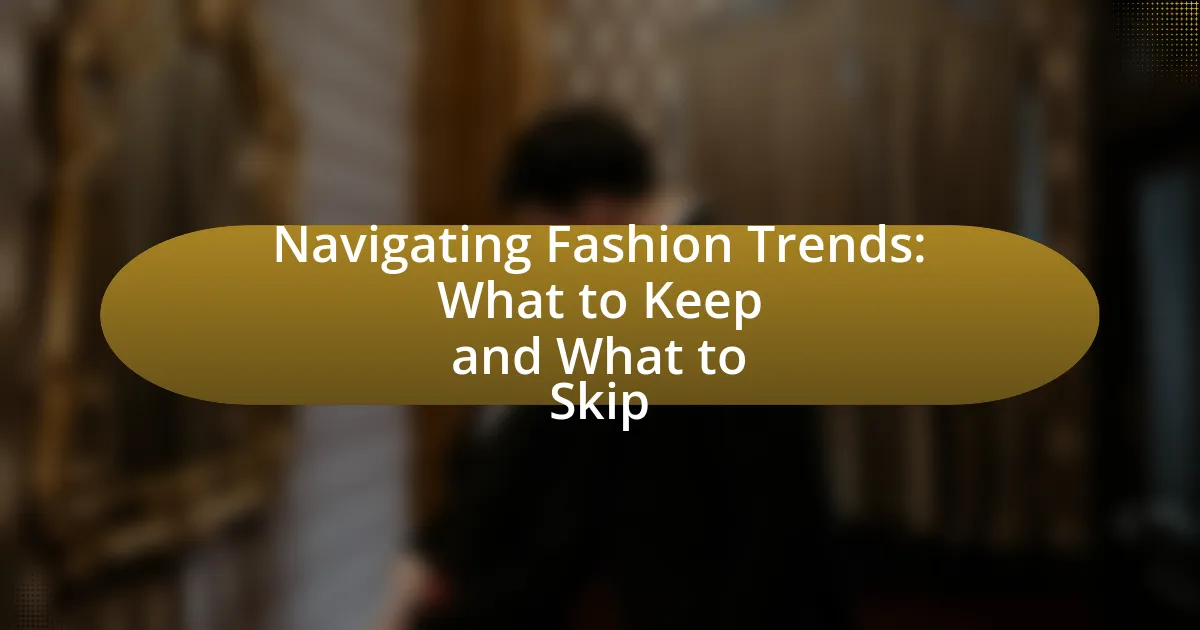
Leave a Reply